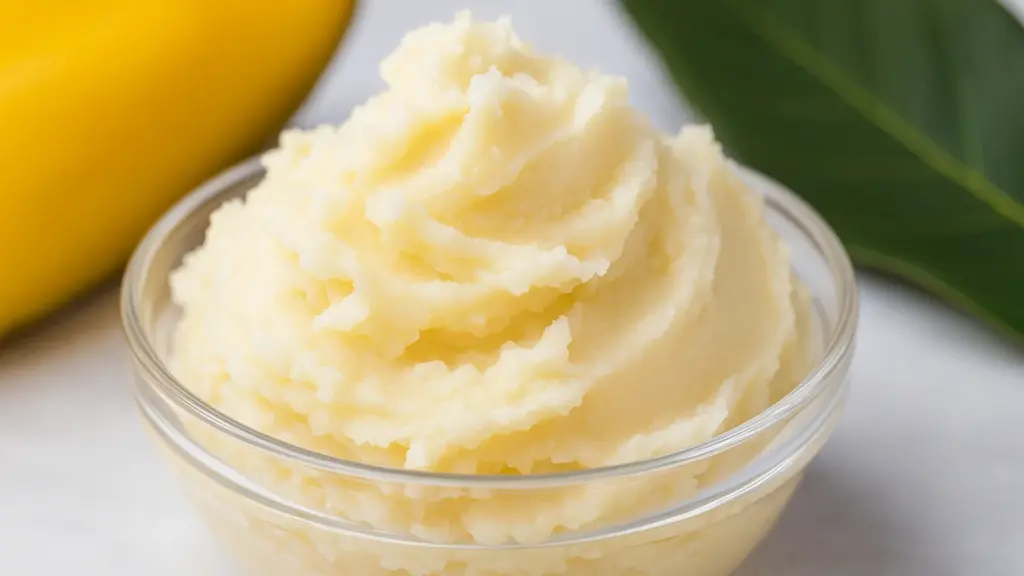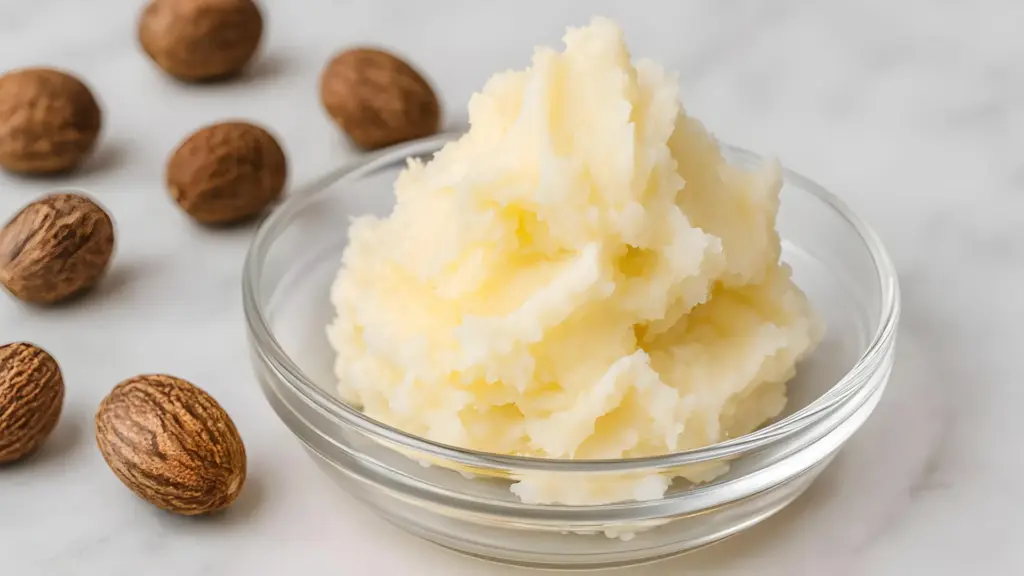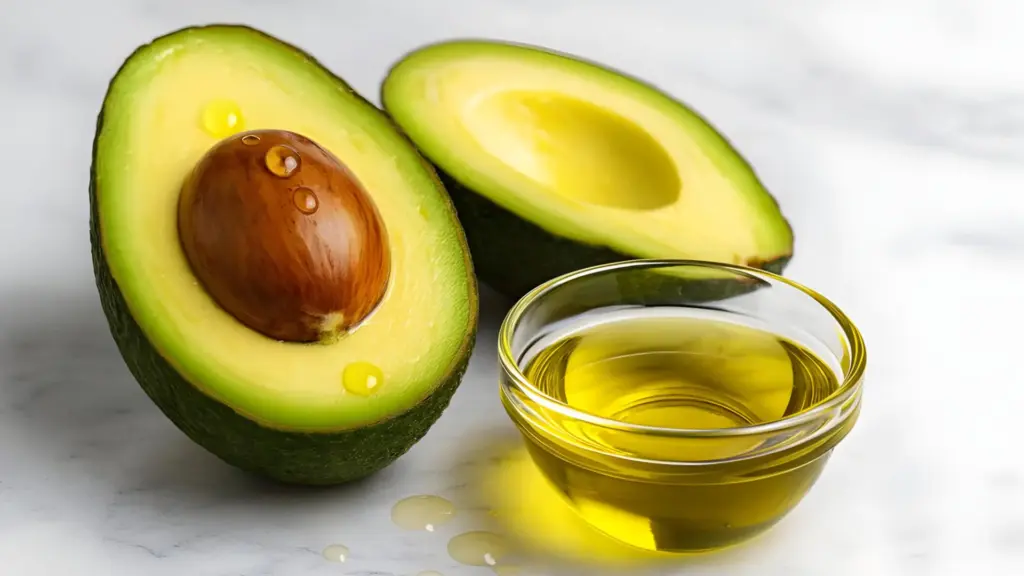If you’ve ever tried to choose between Mango Butter and Shea Butter, you’ll know it’s not an easy call. Both are deeply nourishing, both melt beautifully into the skin, and both leave it softer and healthier. So instead of picking one, I decided to mix them. This Mango Shea Body Butter combines the best of both worlds into a light and fluffy cream that feels luxurious without feeling greasy at all.
Table of Contents
*As an Amazon Associate, I earn from qualifying purchases
It started as an experiment after I’d finished writing about Mango Butter vs Shea Butter and couldn’t quite decide which one I loved more. The two butters turned out to be natural partners – rich, stable, and packed with vitamins A, C, and E. Once whipped together with Avocado, Jojoba, and Coconut oils, they become a nutrient-dense skin treat that melts in easily and keeps moisture locked in for hours.
Whether you live in a warm climate or just like to keep your home cosy, this butter holds its texture without needing beeswax. It’s creamy, velvety, and gives your skin that soft, hydrated glow that lasts all day.
Why Combine Mango Butter and Shea Butter?
Mango and Shea Butters are a natural fit. One gives firmness and lightness; the other brings deep moisture and slip. When you whip them together, they balance each other out.
Shea alone can feel too heavy, and Mango on its own can be a bit dry. The mix gives a butter that holds its shape, spreads well, and keeps skin soft for hours. It’s also more stable in warm weather, so you don’t need to add wax to stop it melting.
You end up with a whipped Mango Shea Body Butter that’s rich, smooth, and easy to use all year round.
Mango Shea Butter Skin Benefits
Mango Shea Butter feeds your skin with vitamins A, C, and E from both butters, plus the fatty acids from the added oils that help repair dryness and seal in moisture. The mix creates a soft barrier that protects against rough weather and keeps skin hydrated for hours without a greasy feel.
It smooths out dry areas like knees, elbows, and heels, and helps calm irritation or flaking. With regular use, it supports healthy skin renewal and brings back a natural, even tone.
Because it’s gentle and deeply nourishing, this butter works well for sensitive or mature skin. It’s ideal to use after bathing, shaving, or sun exposure when your skin needs calm and comfort.
Ingredient Spotlight
Each ingredient has been chosen for what it brings to the mix. The butters give structure and nourishment, the oils add glide and quick absorption, and the Vitamin E keeps everything fresh. Together they make a balanced, skin-friendly base that feels light but lasts. As safe, cosmetic-quality ingredients approved for use within the EU, these materials are all listed on the CosIng website.

Mango Butter
Mango Butter comes from the seed of the mango fruit Mangifera Indica. It is a firm, creamy butter that melts at skin temperature and gives body to a blend without needing wax. This firmness helps the finished butter keep its shape in warm weather and gives a smooth, dry feel on the skin.
It’s packed with Oleic Acid and Stearic Acid, which are great for keeping your skin protected and locking in moisture. It also contains smaller amounts of Palmitic and Linoleic Acids, giving a good balance between nourishment and easy absorption. Mango Butter is loaded with vitamins A, C, and E, which help to reduce oxidative stress and support collagen renewal.
It is gentle enough for baby and sensitive skin. Using it regularly can really help balance out your skin tone on dark areas like your knees and elbows, smooth out rough areas, and keep your skin nice and soft. Mango Butter is great for preventing and reducing stretch marks, especially if you mix it with Shea Butter. Plus, it can really help to strengthen your hair and give it a nice shine when you use it in your hair-care routine.
I also use Mango Butter in this formulation for a Solid Facial Oil along with Grapeseed oil and cannabis. It is also a star ingredient in this multipurpose Conditioning Lotion Bar for Skin and Hair.

Shea Butter
I use almost as much Shea Butter as Mango Butter because they work so well together. Shea is a classic for stretch marks, so pairing it with Mango gives you two powerhouse butters in one blend.
Shea Butter comes from the nut of the Vitellaria Paradoxa tree. It is one of the richest natural emollients available and forms the creamy base of this blend. The butter melts really well at skin temperature, creating a light, protective layer that keeps moisture in without clogging your pores.
It is made up mainly of Oleic and Stearic Acids, giving deep nourishment and a soft, cushiony feel. It also contains Linoleic, Palmitic and Arachidic Acids, which help restore the skin’s barrier and improve elasticity. The natural phytosterols in Shea Butter encourage new cell growth and calm inflammation, making it ideal for dry or irritated skin.
Shea Butter is well known for helping with stretch marks and rough skin. It brings comfort to ashy or flaky areas and helps the skin stay soft, smooth, and resilient. Used often, it supports regeneration and keeps the skin healthy and balanced.
Here is another Shea Butter Body Butter formulation that includes Apricot Kernel Oil which is amazing for sensitive skin.
Jojoba Oil
Jojoba Oil is pressed from the seeds of the desert shrub Simmondsia Chinensis. It is not a true oil but a liquid wax, which makes it very stable and slow to oxidize. If it looks cloudy in cold weather, that is just the wax esters firming up. Warm it gently, and it clears again.
It is rich in monounsaturated fatty acids, mostly Gadoleic Acid (Omega 9) at 66 to 88 percent, Erucic Acid at 10 to 20 percent, and smaller amounts of Oleic Acid and Palmitic Acid. This mix gives Jojoba its smooth, dry feel and long shelf life. It also contains Myristic Acid, known for its anti inflammatory action.
On the skin, Jojoba acts as a temporary occlusive. It slows down moisture loss for around twelve hours but still lets the skin breathe. Because its structure is so close to our natural sebum, it balances oil production, softens blackheads, and clears clogged pores.
Jojoba is suitable for all skin types, even sensitive or acne-prone skin. It locks in moisture, improves flexibility, and leaves the skin soft with a light, non-greasy finish. I use it in this Cannabis-Infused Pumpkin Seed Body Oil formulation, which is very rejuvenating.

Avocado Oil
Avocado Oil is one of the most nourishing oils you can use on the skin. It is rich in Oleic Acid, Palmitic Acid, Linoleic Acid, and the rare Palmitoleic Acid, also known as Omega-7. This mix gives it strong restorative and healing properties and helps it sink into the skin quickly.
It soothes dry, itchy, or irritated skin and is gentle enough for eczema or sensitive areas. The oil is packed with vitamins A, D, and E, which support cell renewal and keep the skin flexible. Regular use gives a healthy sheen and helps dull or dehydrated skin regain softness and bounce.
Avocado Oil also benefits hair and scalp. It can calm dandruff, smooth split ends, and restore shine without feeling heavy or greasy. It blends beautifully with Pomegranate Seed Oil.
Coconut Oil
Coconut Butter (INCI: Cocos Nucifera Seed Butter) is cold-pressed from the flesh of the coconut and then gently deodorised. It has a soft, off-white colour and melts quickly on contact with the skin, usually between 20°C and 28°C. This low melting point gives it a smooth glide and a silky finish, making it ideal for balms, butters, and hair products.
The fatty acid profile primarily includes Lauric Acid (40% to 58%), followed by Myristic Acid (12% to 22%), Caprylic Acid (2% to 16%), Capric Acid (2% to 16%), Palmitic Acid (4% to 12%), and Stearic Acid (1.5% to 12%). This balance gives Coconut Butter excellent emollient and barrier-protective qualities while still melting down easily in the skin.
It conditions dry or rough skin, restores flexibility, and helps strengthen the skin barrier against moisture loss. It also brings natural antibacterial and antifungal support, making it suitable for feet and general body care.
When used in formulations, Coconut Butter adds structure, a rich skin feel, and a soft gloss without heaviness. It goes really well with Mango and Shea Butters. It makes everything smoother and way easier to apply, plus it leaves the final result feeling nice and clean.
Although commonly called Coconut Oil, this product is solid at room temperature and is actually Coconut Butter. Using Fractionated or Liquid Coconut Oil instead will make your Mango Shea Body Butter a bit softer at room temperature.
Vitamin E
Vitamin E is a powerful antioxidant that helps keep the oils and butters in good condition. It slows down oxidation and stops them from going rancid, which means your butter stays fresh for longer. It is often called a preservative, but that is not quite right. It protects the fats, not the product itself. It certainly extends the shelf life of the butters and oils by slowing down oxidation that leads to rancidity, but that doesn’t make it a preservative.
On the skin, Vitamin E helps with scars, stretch marks, and dryness. It supports healing, boosts elasticity, and gives the butter a richer, more protective feel. Keep your bottle in the fridge to maintain its strength and freshness.
Palmarosa Essential Oil
Palmarosa Essential Oil comes from the tall grass Cymbopogon Martinii, part of the same family as lemongrass. The oil is pale yellow with a soft floral scent that blends rose, geranium, and a hint of lemon.
It’s naturally high in Geraniol, usually between 70% to 85%, with smaller amounts of Geranyl Acetate, Farnesol, Linalool, Citronellol, and Caryophyllene. These compounds give Palmarosa its gentle floral scent and its real strength as a skin healer.
It helps to balance sebum and moisture levels, so it suits both dry and oily skin. It supports new cell growth and helps smooth out old scars, acne marks, and stretch marks. Palmarosa has some gentle antibacterial and antifungal properties, which are great for taking care of your feet or any spots that might get a bit hot or irritated.
It blends beautifully into butters and balms, adding a light, clean scent and an extra boost for skin repair. I’d suggest using it at a 1% dilution. At that level, it stays safe and won’t irritate the skin, plus it brings a lot of great benefits to the product!
Mango Shea Body Butter Formulation
For every ingredient, weigh in grams. So in this formulation, 21% Mango Butter is 21g Mango Butter. Even liquids are weighed. 23% Avocado Oil becomes 23g Avocado Oil. This way, the formulation can be doubled or scaled up easily while keeping the same percentages for balance and texture. As it stands, this formulation makes 100g of whipped body butter. For ease of whisking, you might want to double this amount to make a 200g batch.
Ingredients
- 21% Mango Butter
- 19% Shea Butter
- 8% Coconut Butter
- 26% Jojoba Oil
- 23% Avocado Oil
- 2% Vitamin E
- 1% Palmarosa Essential Oil
Method
- Weigh the Mango Butter, Shea Butter, and Coconut Butter into a stainless steel jug or borosilicate beaker. Melt them gently over a double boiler or bain marie. The water underneath prevents overheating so the butters keep their nutrients. They will melt quickly.
- Add the Avocado Oil and Jojoba Oil. Stir with a silicone spatula until the mix is fully blended, then remove it from the heat.
- Place the container in a bowl of ice and water and stir continuously. This cools the mix quickly and helps stop it turning grainy later.
- When the edges start to look opaque, take it out of the ice bath and stir again to keep it smooth.
- Add the Vitamin E and Palmarosa Essential Oil and mix thoroughly.
- Cover with cling film and place in the freezer for short intervals, checking every ten minutes. You want the butter to be thick and pourable, but not set.
- Once it looks like custard, whip it with a cake mixer until light and fluffy. It will increase in volume as air works in.
- Spoon into clean jars and label. Because it is rich, you only need a little at a time, so one batch lasts well.
The finished butter feels rich but light on the skin, melts on contact, and leaves a soft, non-greasy finish.

How to Use Mango Shea Body Butter
Take a small amount with clean, dry fingers or a spatula and warm it between your hands until it melts. Massage into slightly damp skin after a bath or shower to help seal in moisture. Start with a little, as this blend is rich and spreads easily.
Use it daily on dry areas like elbows, knees and heels, or as an all over body moisturiser when your skin feels tight or rough. It also makes a good overnight hand and foot treatment. Apply a thicker layer and cover with cotton gloves or socks if you like.
Since it takes its time to absorb and really gives your skin a nice boost, it’s best to use it in the evening or whenever you’ve got a little downtime to let it sink in properly.
How to Infuse Cannabis into the Oils
To make this body butter cannabis-infused, use the three heat stable oils: Jojoba, Avocado and Coconut. These oils handle gentle heat well and extract cannabinoids and nutrients from dried cannabis while retaining their own benefits.
First decarb your cannabis using the POT by NOIDS or your usual method to activate the CBD or THC. When ready, add Jojoba, Avocado, and Coconut Oils to the pot and choose the CBD or THC infusion setting. When the cycle is complete, strain the oil through the PBN filter to remove the soaked cannabis.
Some oil will stay in the herb. After straining, top the mix back up to your target weight before using it in the body butter formulation. This keeps your base balanced and ensures the cannabinoids are evenly spread for good skin absorption.
As you will have worked out by now, this formulation is exceptionally good to use even without the cannabis. When you use cannabis-infused oils, you get not just extra antioxidants that are good for you but also the cannabinoids and specific terpenes that come from the cannabis strain you used. This is why it is useful to know the terpenes in the essential oil used so that they can enhance eachother. Click the link to read more about the benefits of 26 Cannabis Terpenes.
The cannabinoids and terpenes make this butter a great way to start your day with microdosing as well as a great way to wind down before bed.

Shelf Life and Storage Tips
This butter will stay fresh for around six months if kept in a cool place away from sunlight and heat. Store it in clean, dry jars with tight lids to stop moisture or bacteria getting in.
If your space gets warm, keep it in the fridge to stop it melting or separating. The mix will firm up a little but soften again at room temperature. Always use clean, dry hands or a spatula to scoop it out.
Conclusion
This Mango Shea Body Butter brings together two of the best natural butters with a mix of light, nourishing oils. The result is a smooth, whipped blend that keeps skin soft, hydrated, and protected without any wax or fillers.
It’s easy to adapt, whether you want a simple daily moisturiser or a cannabis infused version for added therapeutic value. The ingredients are stable, gentle, and full of vitamins and fatty acids that feed the skin and keep it healthy.
Once you’ve made this batch, you’ll see how well Mango and Shea work together. It’s a reliable base for future blends and a perfect way to treat your skin naturally.
🎧 Listen Instead
Prefer listening? Play it here or catch it on your favourite platform:
FAQ
What’s the difference between Mango Butter and Shea Butter?
Mango Butter is firm and light. Shea Butter is rich and deeply moisturising. Blending them gives structure, glide, and balance.
Can I mix Mango Butter and Shea Butter without beeswax?
Yes. Mango is firm enough to stabilise the butter on its own, so you don’t need wax that can make it draggy.
Why does homemade body butter go grainy?
That happens when it cools too slowly. Chill it in an ice bath and whip while it’s still soft and custard-like.
Do I need a preservative for body butter?
Not if there’s no water in the mix. Vitamin E slows oxidation and keeps the oils fresh, but it isn’t a preservative.
Can I make a cannabis body butter at home?
Yes. Infuse heat stable oils like Jojoba and Avocado with decarbed cannabis, strain, then whip with butters such as Mango, Shea and Coconut Butters for a rich cannabis body butter.

If you liked this blog post, I would love it if you shared it with a friend.
If you use Pinterest, please pin this post.


 Spotify
Spotify


